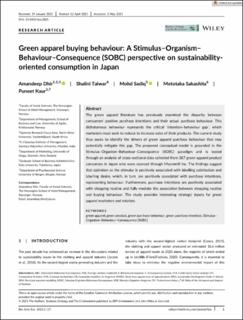| dc.contributor.author | Dhir, Amandeep | |
| dc.contributor.author | Talwar, Shalini | |
| dc.contributor.author | Sadiq, Mohd | |
| dc.contributor.author | Sakashita, Mototaka | |
| dc.contributor.author | Kaur, Puneet | |
| dc.date.accessioned | 2021-08-11T09:03:53Z | |
| dc.date.available | 2021-08-11T09:03:53Z | |
| dc.date.created | 2021-06-08T23:11:40Z | |
| dc.date.issued | 2021 | |
| dc.identifier.issn | 0964-4733 | |
| dc.identifier.uri | https://hdl.handle.net/11250/2767333 | |
| dc.description.abstract | The green apparel literature has previously examined the disparity between consumers' positive purchase intentions and their actual purchase behaviour. This dichotomous behaviour represents the critical ‘intention–behaviour gap’, which marketers must seek to reduce to increase sales of their products. The current study thus seeks to identify the drivers of green apparel purchase behaviour that may potentially mitigate this gap. The proposed conceptual model is grounded in the Stimulus–Organism–Behaviour–Consequence (SOBC) paradigm and is tested through an analysis of cross-sectional data collected from 387 green apparel product consumers in Japan who were sourced through Macromill Inc. The findings suggest that optimism as the stimulus is positively associated with labelling satisfaction and labelling desire, which, in turn, are positively associated with purchase intentions, representing behaviour. Furthermore, purchase intentions are positively associated with shopping routine and fully mediate the association between shopping routine and buying behaviour. The study provides interesting strategic inputs for green apparel marketers and retailers. | en_US |
| dc.language.iso | eng | en_US |
| dc.publisher | Wiley | en_US |
| dc.rights | Navngivelse 4.0 Internasjonal | * |
| dc.rights.uri | http://creativecommons.org/licenses/by/4.0/deed.no | * |
| dc.title | Green apparel buying behaviour: A Stimulus–Organism– Behaviour–Consequence (SOBC) perspective on sustainability-oriented consumption in Japan | en_US |
| dc.type | Journal article | en_US |
| dc.type | Peer reviewed | en_US |
| dc.description.version | publishedVersion | en_US |
| dc.rights.holder | Copyright 2021 The Authors | en_US |
| cristin.ispublished | true | |
| cristin.fulltext | original | |
| cristin.qualitycode | 1 | |
| dc.identifier.doi | 10.1002/bse.2821 | |
| dc.identifier.cristin | 1914691 | |
| dc.source.journal | Business Strategy and the Environment (BSE) | en_US |
| dc.identifier.citation | Business Strategy and the Environment, 2021. | en_US |

